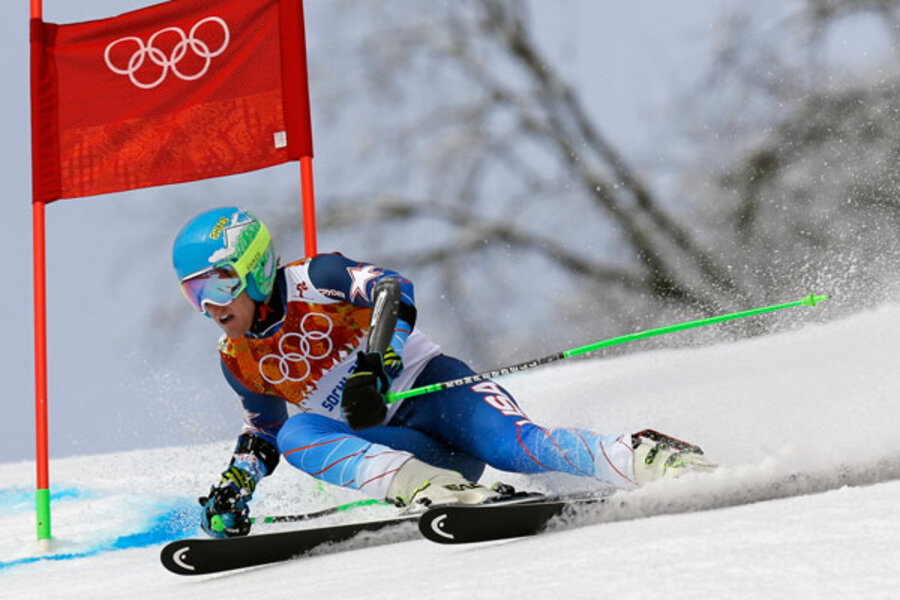Ted Ligety wins Olympic giant slalom gold by reinventing the sport
Loading...
| Krasnaya Polyana, Russia
At one point last season, Marcel Hirscher was fully in awe of Ted Ligety.
Hirscher had just skied a giant slalom race faster than every other person except one. But that one was a big asterisk. It was Ligety, and on that day, Ligety skied 1.76 seconds faster than the second-placed Hischer over two runs.
It was the skiing equivalent of spiking the ball in Hirscher’s face. Ligety hadn’t beaten him, he had crushed him.
"He should ski two or three more gates than the other skiers," Hirscher said at the time.
Later that same season, fellow GS racer Davide Simoncelli took another stab at putting Ligety in perspective: "It's like asking the guy who finishes second in the 100-meter dash, 'How do you catch [Usain] Bolt?' "
Around the skiing world, pretty much everyone knows Ligety is the best giant slalom skier racing today. Now, he has the Olympic gold medal that will shine across the Atlantic. He’s already won an Olympic gold in the combined event in Turin, but this was the one he wanted most. He’s the first non-European to win an Olympic giant slalom and the first American male alpine skier to win two Olympic gold medals.
By Ligety’s standards, Wednesday’s giant slalom at the Sochi Olympics was a bit of a nail-biter.
He won by a half second.
There was a big slip in the second run that drew gasps from the crowd. But it was his first run, which staked Ligety to a nearly one-second lead, that drew gasps of a different sort and ultimately won him the gold medal. That, as Hirscher said once, was classic “Mr. GS.”
Ligety has won the season-long World Cup giant slalom title four times since 2008, including three of the past four years. In a conversation about the best giant slalom skiers of all time, his name must be included, not only for his results, but for his impact on the sport.
In short, these days, everyone is trying to ski GS like him.
A Ligety giant slalom turn is as much a signature as is pen and ink on paper, and around the slopes of Europe, it is seen as nothing less than a revolution in the sport.
The first rule of ski racing is to follow the fall line – the imaginary line down a hill that a ball would take if you tossed it from the top of a pitch. This is the fastest way down the mountain, and the more you get off it, the more time you lose.
But Ligety has essentially blown up that logic, and in his first run Wednesday, he gave a master class.
His style is uniquely suited to giant slalom – not the machine gun staccato of turns needed for slalom or the hell-bent-for-the-bottom schuss of super-giant and downhill. It is a wide, arcing curve in which Ligety leans so close to the snow that his hips appear to kiss the slope.
In the super slow-motion replays shown on the stadium screen here, just Ligety’s body position drew “ooohs” from the crowd, straining credulity even when caught on video.
What Ligety is doing is generating power.
By putting huge pressure on the edges of his skis while still above the gate, Ligety is essentially pulling the rubber band as far as it can go. The downhill carve creates force that is released as increased velocity, and he holds onto his carve so long that he can link it to his next turn.
"He leans down much further than we do, and therefore the ski goes much faster," Simoncelli said last season. "I'm trying everything I can, but I'm not able to imitate him."
Other racers have a “flat spot” in the middle of their turns, where they’re merely gliding until they begin their next turn, said Bode Miller, who finished 20th Wednesday. By contrast, Ligety’s GS turns mean there are few moments when he is not actively creating his own speed.
“In general he just carries speed from turn to turn better,” Miller said. “Because he’s going deeper, his turn is actually longer.”
“Right now if you watch the top guys,… each turn is sort of starting from scratch,” he added. “Ted goes so round that his turn is naturally a longer radius, so by the time his turn finishes, it’s time to go into the next turn.”
In theory, someone taking a straighter line could negate that advantage, but Ligety “just is so consistent he makes no errors, and anybody who’s trying to cut off line just ends up making mistakes, and that makes it a huge gap,” Miller said.
So that leaves everyone to try and copy Ligety. “It’s just that he’s so much better at it than everyone else,” Miller said.
At the end of the first run Wednesday, those turns had put him in first place by 0.92 seconds. The third-place racer was 1.27 seconds behind.
It was, in the end, too much for the field to make up.
Though he’s been on top of world giant slalom for most of the past half decade, he finished a disappointing ninth in Vancouver. Having the Olympic GS gold seemed somehow like justice. Even to those who tried to beat him today.
“He is just brilliant,” said Hirscher, who finished fourth. “The best guy won today.”








